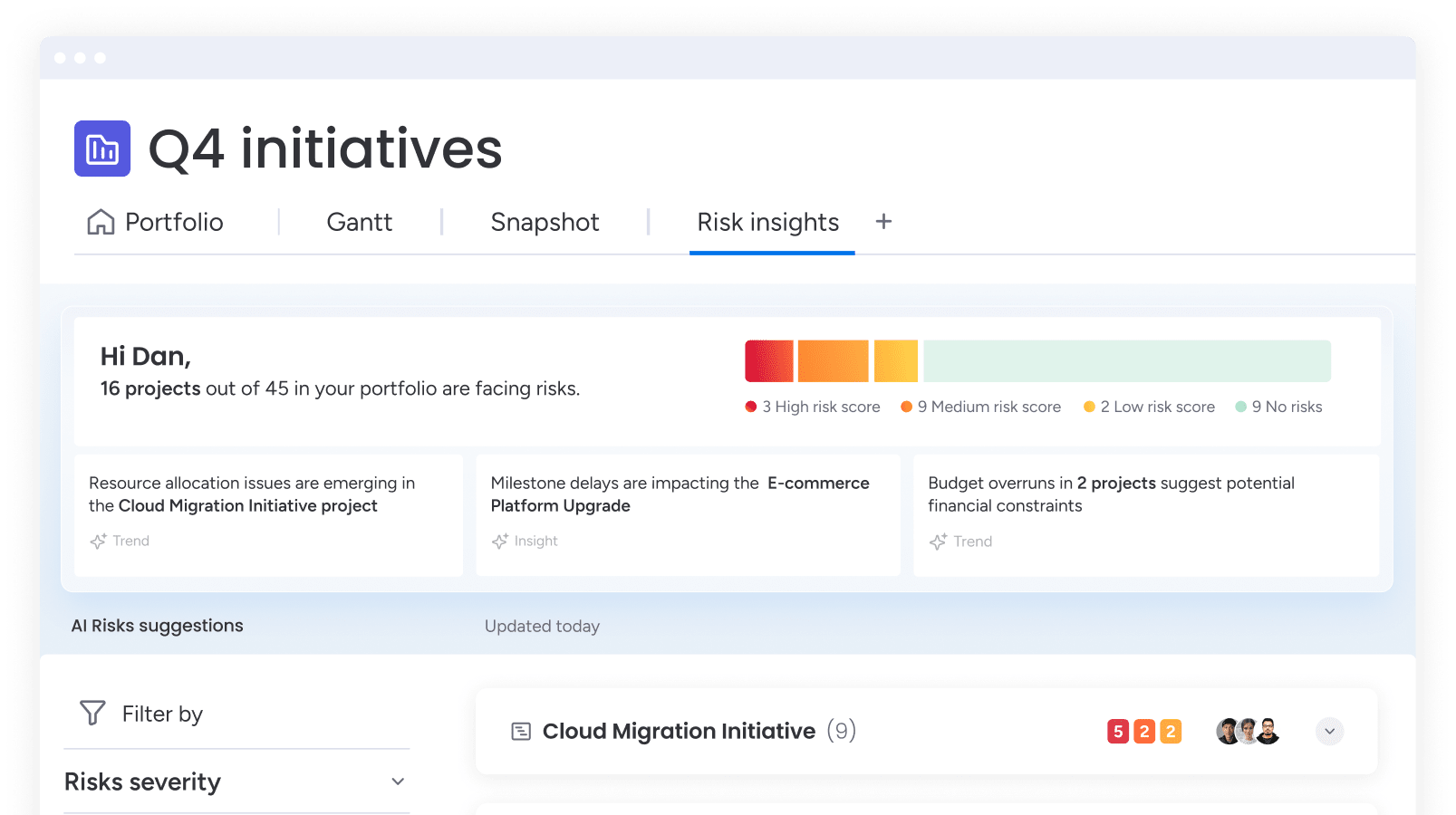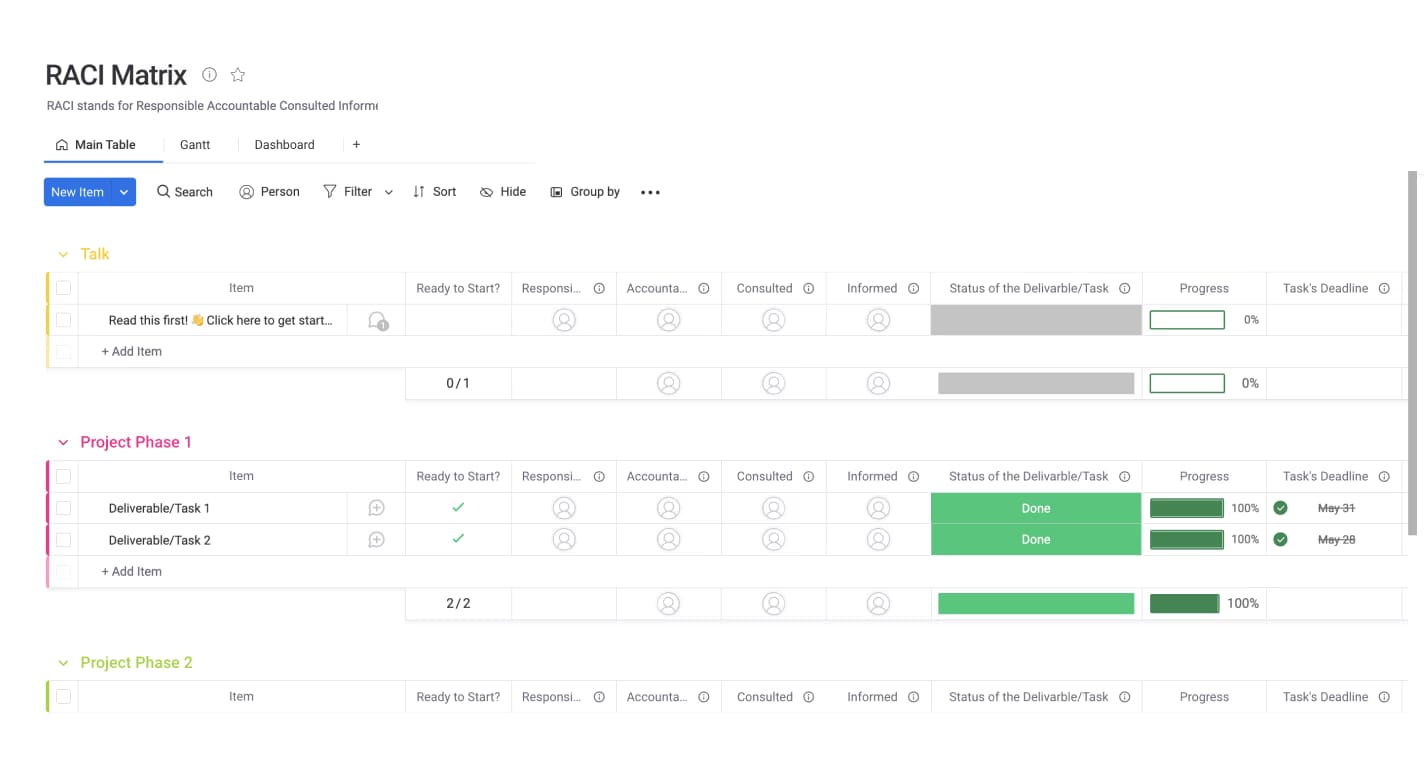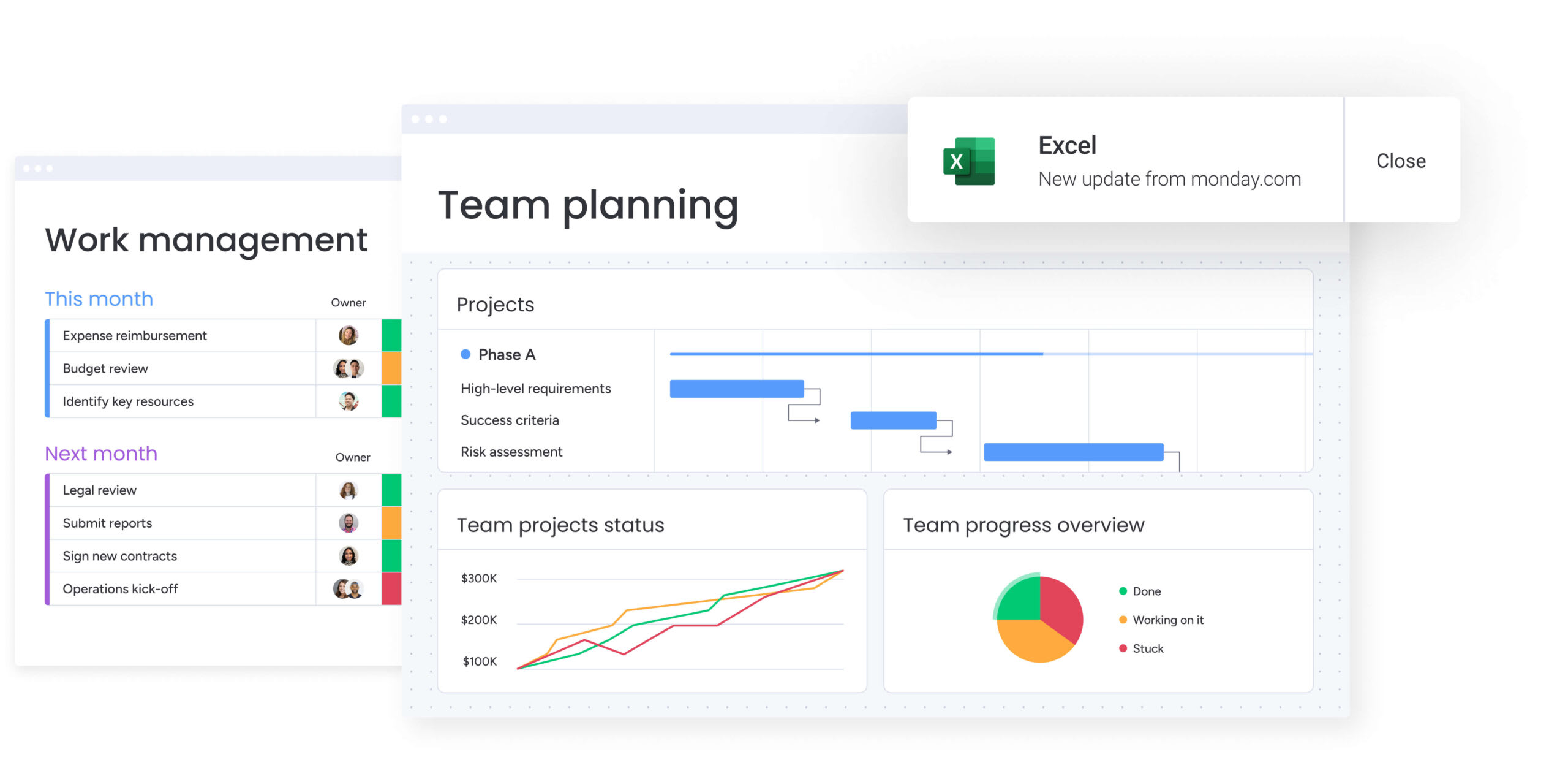Uncertainty is a constant, but how your organization prepares for it makes all the difference. A thoughtful approach to managing potential risks helps you spot issues early, understand what’s at stake, and respond with clarity and confidence. It also brings consistency to how your project teams operate, even when things get unpredictable.
In this article, we’ll break down the essential components of an effective risk management plan, including how to build and scale your approach, tools and templates to support your work, and tips for managing complexity across departments. You’ll also learn how risk management planning ties into broader business success, from identifying potential risks early to developing a strong risk response plan.
Whether you’re leading large initiatives as a project manager or building repeatable systems across your organization, a proactive risk management strategy can help you stay focused and move forward with intention.
What is a risk management plan, and why does it matter?
An effective risk management plan outlines how your project team will surface, evaluate, and proactively respond to potential risks before they cause delays, budget overages, or missed goals.
Larger organizations face greater complexity: more variables, more visibility, and more at stake. Risk management planning helps project managers and leadership teams stay proactive, rather than reactive. It also ensures that everyone, from stakeholders to frontline teams, has clarity on what’s happening, who owns what, and why decisions are being made.
When executed well, an effective risk management plan helps you:
- Flag potential blockers early.
- Assign accountability for the response.
- Focus time and resources where they matter most.
- Keep decision-makers informed.
A thoughtful risk management strategy also supports flexibility. With the right information in the right hands, your organization can adapt quickly, escalate concerns when needed, and protect momentum, reducing the chance that small issues turn into major disruptions.
Risk vs. issues vs. uncertainty
Before diving any deeper with your risk management strategy, it’s important to understand the differences between risks, issues, and uncertainty so you can plan the right actions at the right time.
- A risk is a potential event — something that might happen and impact your outcomes.
- An issue is something that is already happening and needs immediate attention.
- Uncertainty is broader, referring to elements that haven’t yet been fully defined or assessed.
The goal of an effective plan is to give shape to these unknowns so your project team can plan, act, and keep work moving forward with fewer surprises. Early clarity supports smarter prioritization, better resource allocation, and faster recovery when changes arise.
Pro tip: want to have AI analyze all your risks? Check out our new features in our guide to AI-powered risk management.

Start strong: How to lay the groundwork for effective risk management
A strong approach to managing uncertainty should do more than outline tasks; it should create the foundation for project success across functions.
Start by laying a solid groundwork. That begins with a project charter that defines goals and scope, a work plan that maps out timelines and key milestones, and a stakeholder register that clearly outlines who is involved and what they are responsible for. Together, these elements ensure that key stakeholders have a shared understanding of what matters and where potential risks or challenges may arise.
From there, define the essentials of your risk management plan. Set your success criteria early. Clarify what types of risks require immediate attention, how different levels of risk will be prioritized, and when escalation is necessary. Set expectations for how frequently the framework should be reviewed and refined, especially as risk tolerance levels shift over time.
Adapting to uncertainty is not a one-time exercise. Building a strong risk management strategy into your daily operations makes it easier to adjust early and maintain momentum as conditions evolve.
How to build a practical, repeatable risk management plan
You don’t need a complicated system to reduce exposure. A simple, flexible risk management plan grounded in a few core principles can help your team surface issues early, prioritize effectively, and protect project success from start to finish.
Here’s how to build it:
Step 1: Surface what could go off-track
Start with a discovery session that brings together key stakeholders and risk managers from across the business. Your goal is to identify anything that could delay progress, disrupt delivery, or impact outcomes, whether it’s a known issue, an emerging risk, or even a potential opportunity.
Capture everything in a centralized risk register:
- Group potential risks by theme or category.
- Identify who is responsible for monitoring each one.
- Estimate the likelihood of occurrence and the possible negative impact.
Consider the types of risks across your organization, such as technical, operational, external, and organizational, to ensure a wide-angle view. Using a structured template early on makes risk management planning easier and more consistent. It helps your project team spot patterns quickly, assign risk owners from the start, and avoid missing critical details.
Jumpstart your discovery session: Download monday work management’s risk register template.

Step 2: Focus on what matters most
Once the risks are identified, shift your focus to prioritization. Some risks may be low in likelihood or limited in impact, while others could derail timelines, increase costs, or jeopardize project success.
Score each risk based on how likely it is to occur and how significant the impact would be if it does. To analyze more complex risks or projects with higher stakes, consider tools like:
- Probability-impact matrices for visual scoring
- Monte Carlo simulations to explore outcome variability
- Expected monetary value (EMV) to estimate financial exposure
Keep an eye out for early indicators like missed deadlines, resource strain, or communication gaps. These can signal deeper issues brewing under the surface.
And don’t overlook assumption bias. Have your risk managers or peers review your ratings to ensure your evaluation reflects your actual risk tolerance and not just optimism.
Step 3: Assign accountability
For your risk management plan to work, every risk needs a clear risk owner. That doesn’t mean one person will fix everything, but it does mean they’re responsible for tracking progress, surfacing updates, and escalating if things change.
Use a RACI chart (Responsible, Accountable, Consulted, Informed) to clarify:
- Who owns the response
- Who supports the effort
- Who needs to stay informed at each stage
Visibility here is key. A shared dashboard ensures your project manager, risk owners, and stakeholders are all aligned and working from the same information.
Get a head start on accountability: Download monday work management’s RACI template.

Step 4: Define your response
Once risks are prioritized, it’s time to take action. A strong risk mitigation plan reduces the negative impact of potential issues and keeps your projects on track.
There are 5 common ways to respond:
- Avoid: Eliminate the source of the risk entirely.
- Limit: Reduce the probability or severity through proactive controls.
- Transfer: Shift responsibility to an external partner or insurer.
- Accept: Recognize the risk and build a contingency plan.
- Capture: Seize upside opportunities when they add value.
Your risk response plan should include specific actions for each response, a clear escalation path, and a timeline for revisiting unresolved items. Use a RAID log, which stands for Risks, Assumptions, Issues, and Dependencies, to track decisions and escalate when needed.
Step 5: Monitor, adapt, and archive
The most effective risk management strategies are the ones your teams can sustain. This means making updates, status checks, and refinements part of your regular workflow, not something bolted on at the end.
Here’s how:
- Set recurring check-ins to reassess open risks.
- Add risk-related updates to project status reports.
- Track resolution timelines and connect risks to KPIs.
Distinguish between future-facing risks and current issues. Possible threats should live on a monitored watchlist. Active concerns need immediate response.
When your project wraps, archive your tracker for future reference. This becomes a valuable asset for future planning, helping your project team move faster next time and refine your overall risk management strategy.
Want to learn more about project risk management? Check out these 6 steps to succeed.
Why leadership is critical to risk management success
Top-level involvement isn’t just helpful — it’s essential. Without it, even the best plans lose momentum.
When leaders are involved in early planning, they model accountability. They also help teams focus on what matters and act quickly when something needs attention.
High-level ownership supports:
- Visibility across departments and business areas
- Clarity on what’s worth watching and who’s keeping an eye on it
- Connection between planning and actual delivery
Assign executive sponsors to major areas of concern, like resourcing, external dependencies, or cost exposure. This makes it easier to cut through red tape, resolve conflicts, and speed up decisions.
Set up systems that surface key updates without creating noise. Dashboards and check-ins should keep information current, visible, and actionable, whether that’s for a team lead or a board-level stakeholder.
The goal isn’t to hover over every detail. It’s to stay connected to the bigger picture and step in early when something important starts to shift.
Customizing your approach by team or function
Every department has its own tools, timelines, and risk factors, which means your plan needs to flex across functions. While the core framework stays consistent, the way you apply it should reflect the realities of each group.
Here’s how common risks can show up across different parts of the business — and how to manage them:
Department Common risk factors How to manage
Product development Overlapping timelines, unresolved technical debt, shared engineering bandwidth Use backlog prioritization, allocate dedicated engineering resources, tighten sprint planning.
Finance & audit Evolving regulations, third-party dependencies, aging infrastructure Maintain a compliance calendar, audit vendor contracts regularly, invest in modernized systems.
Marketing & creative ops Campaign delays, reliance on external platforms, last-minute changes Build in creative buffers, create channel contingency plans, formalize approval timelines.
Construction & field ops Permit delays, subcontractor availability, seasonal and regional disruptions Plan for regional regulations early, maintain multiple vendor relationships, adjust by seasonality.
When teams can tailor how they monitor and respond to risk, without abandoning a shared structure, they’re better equipped to act quickly and stay aligned.
With monday work management, you can build department-specific workflows, set conditional alerts, and customize fields based on functional needs. That way, every team gets what they need, while leadership still sees the full picture.
How to extend your risk management plan across the business
Managing issues at the task or team level is important, but it’s only part of the picture. To truly reduce exposure across your organization, you need visibility into how uncertainty impacts work at scale.
That’s where enterprise risk management (ERM) comes in. ERM takes a broader view, helping you connect what’s happening day to day with what your company is working toward long term. It’s not just about timelines and budgets. It’s also about identifying and addressing deeper challenges, such as operational bottlenecks, financial exposure, compliance concerns, or shifts in market conditions and technology.
Rather than managing isolated projects, you’re building a repeatable system that helps decision-makers across teams and regions work from a shared view — and take action quickly when needed.
With monday work management, you can organize your plan by portfolio, location, or business function using AI-driven insights. Set up dashboards that highlight trends, surface recurring blockers, or trigger alerts based on specific inputs. When the whole organization is working from the same framework, it’s easier to stay agile — even when things are changing fast.
Tools and templates to stay ahead of uncertainty
Building a system you can rely on starts with a few foundational resources. These tools help you organize, track, and act without having to start over every time a new challenge surfaces.
Here are a few key resources to help streamline your setup:
- Tracker template: Centralize risks, owners, categories, and next steps.
- Risk breakdown structure (RBS): Organize potential problems by theme: operational, technical, external, or organizational.
- Priority matrix: Evaluate impact and likelihood to decide what needs attention first.
- RAID log: Track risks, assumptions, issues, and dependencies in a compact view.
- Custom dashboards: Create live boards that surface key information, flag updates, and alert the right people automatically.

All of these tools are available inside monday work management, so you’re not chasing down spreadsheets, toggling between platforms, or manually updating documents.
Want to try it out? Start with our customizable project tracker template.

Build smarter risk plans with monday work management

When potential issues surface and teams aren’t aligned, delays, confusion, and missed handoffs tend to follow. Risk tracking isn’t enough. You need a system that helps you act before they become blockers.
This is where monday work management makes a difference. It brings together the structure and flexibility needed to help teams identify, evaluate, and manage uncertainty with confidence.
With this platform, you can:
- Centralize your risk register in one board that tracks potential issues, assigns ownership, and updates status in real time.
- Surface early warning signs like timeline shifts, capacity dips, or repeated blockers using dashboards.”
- Standardize your workflows with templates for RACI charts, scoring systems, and escalation paths that can be easily reused across departments.
- Create the right level of visibility for every audience, from cross-functional contributors to senior leadership.
- Stay flexible as conditions change by updating fields, owners, or workflows without disrupting the system.
Whether you’re refining an existing plan or starting from scratch, monday work management helps you stay ahead of the curve with clarity and control at every level.
Why enterprise teams choose monday work management
Managing risk across a large organization means managing complexity, and monday work management is built for exactly that.
Here’s how the platform supports fast-moving organizations tackling complex risks and operational complexity:
- Consistency with flexibility: Standardize core workflows across the business while giving departments the freedom to customize based on real-world needs.
- High adoption, better data: A user-friendly experience keeps engagement high, making dashboards more accurate and decisions faster.
- Fast setup and ongoing iteration: Use low-code templates to roll out frameworks quickly, and adjust them easily as priorities change.
- Enterprise-grade security: Protect sensitive operational and compliance data with strict access controls and audit-ready infrastructure.
- Integrated by design: Seamlessly connect systems like Salesforce, Workday, or Jira for a unified, enterprise-wide view of your workflows.
- Built to evolve: Continuous product updates, shaped by enterprise customer feedback, help you stay ahead of shifting risks and new business challenges.
Together, these capabilities create a system that doesn’t slow you down — it strengthens your ability to respond, recover, and keep moving.
Bring order to uncertainty with a risk management plan
No business can eliminate risk, but every organization can improve how it prepares, responds, and adapts. Building a reliable approach means fewer surprises, more confident decisions, and stronger results across the board.
You can build an approach that’s flexible enough for frontline teams and powerful enough for executive visibility — all with monday work management. It makes tracking issues, surfacing patterns, and acting on key decisions a shared plan, not a siloed task.
Ready to put a smarter system in place (like a risk management software, for example)? Explore how monday work management can help you stay ready, stay aligned, and stay ahead.
FAQs
What are the 5 risk response types?
The 5 risk response types are:
- Avoiding
- Minimizing
- Transferring
- Accepting
- Capitalizing
These are each based on how serious or likely the issue is.
What are the 4 main parts of a risk approach?
The 4 main parts of a risk approach are:
- Finding potential blockers
- Assessing impact
- Planning responses
- Tracking progress over time
How often should teams revisit their risk documentation?
Teams should revisit their risk documentation every quarter or whenever goals, timelines, or staffing shifts. A good plan keeps pace with the work.
Is there value in keeping records after a project ends?
Yes, there is value in keeping records after a project ends. Past documentation helps you move faster next time and avoid repeat problems.
- Tags:
- Project risk management
